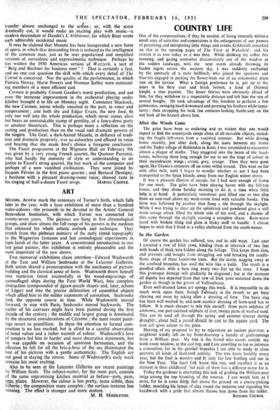ART
MESSRS. AGNEW mark the centenary of Turner's birth, which falls later in the year, with a loan exhibition of more than a hundred water-colours—the proceeds to be devoted to the Artists' General Benevolent Institution, with which Turner was connected for twenty-seven years. The pictures arc hung in five chronological groups, and show almost the full range of his powers in the medium that coloured his whole artistic outlook and technique. They stretch from the plebeian mimicry of the early tinted topography to the Wagnerian fantasies and last cosmological experiments in lapis lazuli of the latter years. A concentrated introduction to our last great painter, this exhibition is entirely pleasurable and the most important of the pew shows.
Two memorial exhibitions claim attention—Edward Wadsworth at the Tate and William Seabrooke at the Leicester Galleries. Both artists shared a preoccupation with the mechanics of picture- building and the classical sense of form. Wadsworth threw himself into vorticism (most successfully in his wood-engravings of camouflaged ships during the First World War), Into complete abstraction (compounded of jigsaw-puzzle shapes and, later, echoes of Leger) and into the precise delineation of assembled objects which allied him to the milder exponents of surrealism. Seabrooke took the opposite course in time. While Wadsworth moved forward, in step with Paris, Seabrooke moved backwards. The earlier of his canvases might have been painted during the first decade of the century ; the middle and largest group is dominated by the structural considerations of Cezanne ; the most recent paint- ings revert to pointillism. In these the attention to formal com- position is no less marked, but is allied to a careful observation of tonal values and a richer warmth of colour. Wadsworth's love of tempera led him to harder and more decorative statements, but he was capable on occasion of sonorous harmonies, and the affection he felt for all the bric-A-brac of the sea illuminated the best of his pictures with a gentle authenticity. The English are not good at staying the course. Some of Wadsworth's early work remains his most exciting.
Also to be seen at the Leicester dalleries are recent paintings by William Scott. The subject-matter, for the most part, consists of the same unpromising kitchen material as before—pots, pans, eggs, plates. However, the colour is less pretty, more subtle, than hitherto ; the composition more complex ; the surface textures less winning. The effect is stronger and more mature. ,
M. H. MIDDLETON.


































 Previous page
Previous page